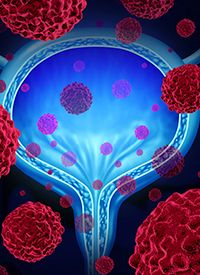Feature
Article
Mitomycin Gel May Have a Place in Chemo-Ablative Cytoreduction of Higher-Volume, Low-Grade UTUC
Author(s):
Patients with low-grade upper tract urothelial carcinoma experienced similar rendered disease free rates, regardless of surgery type or tumor volume, following treatment with mitomycin for pyelocalyceal solution.
Mitomycin Gel in Higher-Volume,
Low-Grade UTUC | Image Credit:
© freshidea - stock.adobe.com

Patients with low-grade upper tract urothelial carcinoma (UTUC) experienced similar rendered disease free (RDF) rates, regardless of surgery type or tumor volume, following treatment with mitomycin for pyelocalyceal solution (Jelmyto), according to findings from a retrospective study published in announced by the agent’s manufacturer UroGen Pharma.1 Data from the study were published in May 2023 in Urologic Oncology: Seminars and Original Investigations.2
Results from the study showed that at first ureteroscopy following mitomycin gel, no significant difference in RDF rates was noted among patients regardless of undergoing complete ablation (n = 50), partial ablation (n = 42), or biopsy alone (n = 20) at initial ureteroscopy (P = .15). The RDF rates were 78.6%, 57.6%, and 66.7%, respectively. Moreover, varying tumor size prior to mitomycin gel induction (completely ablated, < 1 cm, 1 to 3 cm, or > 3 cm) did not lead to significant differences in RDF rates (P = .17).2
Findings from the study showed that patients initially treated with complete mechanical ablation had a higher complete response (CR) to mitomycin gel at first surveillance ureteroscopy compared with those who received partial ablation or biopsy only, at 76.2% vs 39.4% vs 53.3%, respectively (P = .02).
In terms of tumor size, the RDF rates achieved with mitomycin gel without complete ablation were 87.5% for tumors less than 1 cm, 52.0% for tumors 1 to 3 cm, and 66.7% for tumors over 3 cm. Comparatively, the RDF rate prior to mitomycin for completely ablated tumors was 78.6% (P = .09).2
Mitomycin gel was approved by the FDA for the treatment of patients with low-grade UTUC in April 2020, based on data from the phase 3 OLYMPUS trial (NCT02793128).3
The real-world, retrospective study included data from 15 high-volume academic and community centers. To be eligible for inclusion, patients needed to have UTUC initially diagnosed or treated with endoscopy and followed with mitomycin gel. All patients received mitomycin following ureteroscopy irrespective of initial ablation approach.2
Investigators collected data on patients with high-grade UTUC treated from October 2020 to February 2022 but did not include it in their analysis. They also excluded patients with pT3 stage disease or greater on nephroureterectomy within 6 months of receiving mitomycin gel, those without available pathology, and those who received systemic therapy for distant progression within 6 months of mitomycin gel treatment.2
The primary outcome was RDF, defined as having an absence of any tumor or a nearly CR requiring only minimal mechanical ablation. CR to chemoablation with mitomycin gel, ablation results by tumor size, and ureteral stricture rates represented secondary outcomes.2
The median age among patients who received complete ablation was 73.5 years (range, 67-81). Most patients were men (n = 33), former smokers (n = 27), had a first diagnosis of UTUC (n = 36), and did not receive maintenance mitomycin gel (n = 29). Thirty-seven patients completed full induction with the remaining 13 receiving less than 6 doses of mitomycin.2
In the partial ablation arm, the median age was 74 years (range, 68-76). Most patients were men (n = 30), former smokers (n = 26), had a first diagnosis of UTUC (n = 34), did not receive maintenance mitomycin gel (n = 27), and underwent a complete course of mitomycin gel induction (n = 30). Following mitomycin gel instillation, patient tumor sizes were less than 1 cm (n = 8), 1 to 3 cm (n = 24), over 3 cm (n = 9), or missing (n = 1).2
Finally, in the biopsy only arm, the median age was 78.5 years (range, 71.4-84). Most patients were men (n = 16), former smokers (n = 13), had a first diagnosis of UTUC (n = 15), did not receive maintenance mitomycin gel (n = 17), and underwent a complete course of mitomycin gel induction (n = 14). Tumor sizes after mitomycin gel instillation were less than 1 cm (n = 3), 1 to 3 cm (n = 8), over 3 cm (n = 7), or missing (n = 2).2
Investigators noted that their study was limited by its retrospective nature, variability of practices between different institutions, and limiting data to initial response without including findings on recurrence of durability of response. They also stressed that this was an early analysis of a novel therapeutic and the effect of maintenance therapy with mitomycin gel on those who had a partial response that was considered RDF after mechanical ablation is not currently known and warrants further study.
However, investigators concluded that mitomycin demonstrated a chemo-ablative effect and that the agent, “… may play a role in initial chemo-ablative cytoreduction of larger volume low-grade tumors that may not initially appear to be amenable to renal preservation, enabling an additional strategy for clinicians to employ. Patients with larger low-grade tumors may benefit from upfront [mitomycin gel] administration with subsequent posttreatment mechanical ablation for renal preservation.”
References
- Retrospective study finds Jelmyto use effective following partial ablation or biopsy in larger volume low-grade upper tract urothelial tumors that impede kidney preservation. News release. UroGen Pharma Limited. July 10, 2023. Accessed July 18, 2023. https://www.biospace.com/article/releases/retrospective-study-finds-jelmyto-use-effective-following-partial-ablation-or-biopsy-in-larger-volume-low-grade-upper-tract-urothelial-tumors-that-impede-kidney-preservation/
- Kaimakliotis HZ, Tachibana I, Woldu S, et al. The ablative effect of mitomycin reverse thermal gel: expanding the role for nephron preservation therapy in low grade upper tract urothelial carcinoma. Urol Oncol. Published online May 26, 2023. doi:10.1016/j.urolonc.2023.04.010
- FDA approves mitomycin for low-grade upper tract urothelial cancer. FDA. April 15, 2020. Accessed July 24, 2023. https://wayback.archive-it.org/7993/20201222063400/https://www.fda.gov/drugs/resources-information-approved-drugs/fda-approves-mitomycin-low-grade-upper-tract-urothelial-cancer





%20(2)%201-Recovered-Recovered-Recovered-Recovered-Recovered.jpg?fit=crop&auto=format)

%20(2)%201-Recovered-Recovered-Recovered-Recovered-Recovered.jpg?fit=crop&auto=format)
%20(2)%201-Recovered-Recovered-Recovered-Recovered-Recovered.jpg?fit=crop&auto=format)